
List of weight training exercises
Encyclopedia
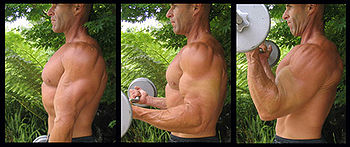
Overview
The human body can be broken down into different muscles and muscle groups. The muscles can beworked and strengthened by exercise. This table shows major muscles and the exercises used to work and strengthen that muscle.
Squat

Squat (exercise)
In strength training, the squat is a compound, full body exercise that trains primarily the muscles of the thighs, hips and buttocks, quads , hamstrings, as well as strengthening the bones, ligaments and insertion of the tendons throughout the lower body...
is performed by squatting down with a weight held across the upper back and standing up straight again. This is a compound exercise that also involves the glutes (buttocks) and, to a lesser extent, the hamstrings, calves
Triceps surae muscle
The triceps surae is a pair of muscles located at the calf - the gastrocnemius and the soleus...
, and the lower back. Lifting belts are sometimes used to help support the lower back, as are tight-fitting "squat suits" which compress the lower torso. The freeweight squat is one of 'The Big Three' powerlifting
Powerlifting
Powerlifting is a strength sport. It resembles the sport of Olympic weightlifting, as both disciplines involve lifting weights in three attempts. Powerlifting evolved from a sport known as 'odd lifts' which followed the same three attempt format but used a wide variety of events akin to Strongman...
exercises, along with the deadlift and the bench press.
Equipment: Squats can be performed using only the practitioner's body weight. For weighted squats, a barbell
Barbell
A barbell is a piece of exercise equipment used in weight training, weightlifting and powerlifting. Barbells range in length from to although bars above 7' in length are used primarily by powerlifters and aren't commonplace...
is typically used, although the practitioner may instead hold dumbbell
Dumbbell
The dumbbell, a type of free weight, is a piece of equipment used in weight training. It can be used individually or in pairs .-History:...
s, kettlebell
Kettlebell
The kettlebell or girya is a cast-iron weight used to perform ballistic exercises that combine cardiovascular, strength and flexibility training.Sizes may range from to...
s, or other weighted objects. Individuals uncomfortable performing freeweight squats may use a Smith machine
Smith machine
The Smith machine is a piece of equipment used in weight training. It consists of a barbell that is fixed within steel rails, allowing only vertical movement. New variations allow a small amount of forward and backward movement. A Smith machine often includes a weight rack in the base to help...
or hack squat machine.
Major variants: Common variations include front squats, in which the weight is held across the upper chest, and box squats, in which the practitioner rests briefly on a box or bench at the bottom of the movement.
Leg press

Leg press
The leg press is a weight training exercise in which the individual pushes a weight or resistance away from them using their legs. The term leg press also refers to the apparatus used to perform this exercise...
is performed while seated by pushing a weight away from the body with the feet. It is a compound exercise that also involves the glutes and, to a lesser extent, the hamstrings and the calves. Overloading the machine can result in serious injury if the sled moves uncontrollably towards the trainer.
Equipment: Leg press machine.
Deadlift
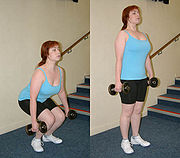
Deadlift
The deadlift is a weight training exercise where a loaded barbell is lifted off the ground from a stabilized, bent over position. It is one of the three canonical powerlifting exercises, along with the squat and bench press.-Overview:...
is performed by squatting down and lifting a weight off the floor with the hand until standing up straight again. Grips can be face down or opposing with one hand down and one hand up, to prevent dropping. Face up should not be used because this puts excess stress on the inner arms. This is a compound exercise that also involves the glutes, lower back, lats, trapezius (neck) and, to a lesser extent, the hamstrings and the calves. Lifting belts are often used to help support the lower back. The deadlift consist of two common exercises the Romanian deadlift and the straight-leg-deadlift. Each target the lower back, glutes and the hamstrings differently.
Equipment: Dumbbells, barbell, trapbar or Smith machine.
Major variants: Sumo (wider stance to emphasise the inner thighs); stiff legged (emphasizes hamstrings); straight-legged deadlift (emphasizes lower back).
Leg extension

Leg extension
The leg extension is a resistance weight training exercise that targets the quadriceps muscle in the legs. The exercise is done using a machine called the Leg Extension Machine. There are various manufacturers of these machines and each one is slightly different. Most gym and weight rooms...
is performed while seated by raising a weight out in front of the body with the feet. It is an isolation exercise for the quadriceps. Overtraining
Overtraining
Overtraining is a physical, behavioral, and emotional condition that occurs when the volume and intensity of an individual's exercise exceeds their recovery capacity. They cease making progress, and can even begin to lose strength and fitness...
can cause patellar tendinitis. The legs extension serves to also strengthen the muscles around the knees and is an exercise that is preferred by physical therapists.
Equipment: Dumbbell, cable machine or leg extension machine.
Wall Sit
The wall sit, also known as a static squat, is performed by placing one's back against a wall with feet shoulder width apart, and lowering the hips until the knees and hips are both at right angles. The position is held as long as possible. The exercise is used to strengthen the quadriceps.Contrary to previous advice in this section, this exercise is NOT good for people with knee problems because the knees bear most of the load, especially when they are held at right angles (90 degrees).
Equipment: Body weight, wall or other flat vertical surface, exercise ball placed behind the back is optional as well
Leg curl

Leg curl
The Leg curl is an isolation exercise that targets the hamstring muscles. The exercise involves flexing the lower leg against resistance towards the buttocks....
is performed while lying face down on a bench, by raising a weight with the feet towards the buttocks. This is an isolation exercise for the hamstring
Hamstring
In human anatomy, the hamstring refers to any one of the three posterior thigh muscles, or to the tendons that make up the borders of the space behind the knee. In modern anatomical contexts, however, they usually refer to the posterior thigh muscles, or the tendons of the semitendinosus, the...
s.
Equipment: Dumbbell, cable machine or leg curl machine.
Major variants: Seated (using a leg curl machine variant); standing (one leg at a time).
Snatch
The snatchSnatch (weightlifting)
The snatch is one of the two olympic weightlifting events .The essence of the event is to lift a barbell from the platform to locked arms overhead in a smooth continuous movement. The barbell is pulled as high as the lifter can manage at which point the barbell is flipped overhead...
is one of the two current olympic weightlifting events (the other being the clean and jerk
Clean and jerk
The clean and jerk is one of the two Olympic weightlifting events .The clean portion of the lift refers to the lifter explosively pulling the weight from the floor to a racked position across deltoids and clavicles...
). The essence of the event is to lift a barbell from the platform to locked arms overhead in a smooth continuous movement. The barbell is pulled as high as the lifter can manage (typically to mid chest height) (the pull) at which point the barbell is flipped overhead. With relatively light weights (as in the "power snatch") locking of the arms may not require rebending the knees. However, as performed in contests, the weight is always heavy enough to demand that the lifter receive the bar in a squatting position, while at the same time flipping the weight so it moves in an arc directly overhead to locked arms. When the lifter is secure in this position, he rises (overhead squat), completing the lift.
Standing calf raise
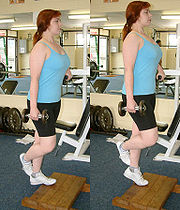
Calf (anatomy)
In human anatomy the calf is the back portion of the lower leg . In terms of muscle systems, the calf corresponds to the posterior compartment of the leg. Within the posterior compartment, the two largest muscles are known together as the calf muscle and attach to the heel via the Achilles tendon...
; it particularly emphasises the gastrocnemius muscle
Gastrocnemius muscle
In humans, the gastrocnemius muscle is a very powerful superficial pennate muscle that is in the back part of the lower leg. It runs from its two heads just above the knee to the heel, and is involved in standing, walking, running and jumping. Along with the soleus muscle it forms the calf muscle...
, and recruits the soleus muscle
Soleus muscle
- References :* Gray, Henry. Pick, T. Pickering, & Howden, Robert . Gray's Anatomy . New York: Barnes & Noble Books.- External links :...
.
Equipment: Body weight, dumbbells, barbell, Smith machine or standing calf raise machine.
Major variants: One leg (the other is held off the ground); donkey calf raise (bent over with a weight or machine pad on the lower back).
Seated calf raise
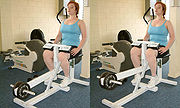
Soleus muscle
- References :* Gray, Henry. Pick, T. Pickering, & Howden, Robert . Gray's Anatomy . New York: Barnes & Noble Books.- External links :...
.
Equipment: Barbell or seated calf raise machine; can also be done on a leg press machine.
Hip abduction
The hip abduction exercise is performed by opening the legs while sitting, thereby pushing a machine's pads resting on the outside of the hips apart. This is an isolation exercise for the gluteus muscles of the hipMuscles of the hip
In human anatomy, the muscles of the hip joint are those muscles that cause movement in the hip. Most modern anatomists define 17 of these muscles, although some additional muscles may sometimes be considered...
. It is not generally necessary to exercise the hip abductor muscles in isolation, as they are in use during exercises such as the squat and lunge.
Equipment: Hip abduction and adduction machine.
Hip adduction
The hip adduction exercise is performed by closing the legs while sitting, thereby pushing a machine's pads resting on the inside of the hips together. This is an isolation exercise for the adductor muscles of the hipAdductor muscles of the hip
In human anatomy, the adductor muscles of the hip is a group of muscles of the thigh.-Muscles:The adductor group is made up of:*Adductor brevis*Adductor longus*Adductor magnus*Adductor minimus This is often considered to be a part of adductor magnus....
, and is generally only necessary for people practicing sports that overuse these muscles.
Equipment: Hip abduction and adduction machine.
PectoralsPectoralis major muscleThe pectoralis major is a thick, fan-shaped muscle, situated at the chest of the body. It makes up the bulk of the chest muscles in the male and lies under the breast in the female...
(chest)
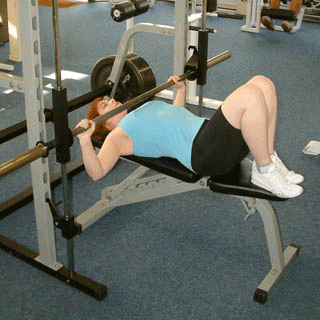
- The bench pressBench pressThe bench press is an exercise of the upper body. For bodybuilding purposes, it is used to stimulate the pectorals, deltoids, and triceps. While on his or her back, the person performing the bench press lowers a weight to the level of the chest, then pushes it back up until the arm is straight...
is performed while lying face up on a bench, by pushing a weight away from the chest. This is a compound exercise that also involves the triceps and the front deltoids, also recruits the upper and lower back muscles, and traps. The bench press is the king of all upper body exercises and is one of the most popular chest exercises in the world. It is the final exercise in 'The big 3'.- Equipment: dumbbells, barbell, Smith machine or bench press machine.
- Major variants: incline ~ (more emphasis on the upper pectorals), decline ~ (more emphasis on the lower pectorals), narrow grip ~ (more emphasis on the triceps), push-up (face down using the body weight), neck press (with the bar over the neck, to isolate the pectorals), vertical dips (using parallel dip bars) or horizontal dips (using two benches with arms on the near bench and feet on the far bench, and dropping the buttocks to the floor and pushing back up.)
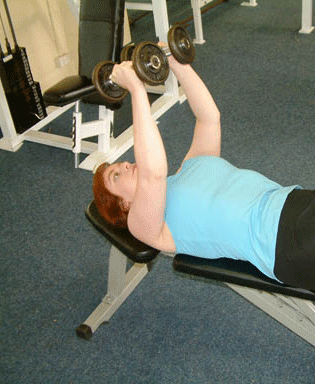
- The chest fly is performed while lying face up on a bench or standing up, with arms outspread holding weights, by bringing the arms together above the chest. This is a compound exercise for the pectoralsPectoralis major muscleThe pectoralis major is a thick, fan-shaped muscle, situated at the chest of the body. It makes up the bulk of the chest muscles in the male and lies under the breast in the female...
. Other muscles worked include deltoids, triceps, and forearmForearm-See also:*Forearm flexors*Forearm muscles...
s.- Equipment: dumbbells, cable machine or "pec deck" machine.
- Major variants: incline ~ (more emphasis on the upper pectorals), decline ~ (more emphasis on the lower pectorals), cable crossover.
- Cable crossovers
- Dips
LatsLatissimus dorsi muscleThe latissimus dorsi , meaning 'broadest muscle of the back' , is the larger, flat, dorso-lateral muscle on the trunk, posterior to the arm, and partly covered by the trapezius on its median dorsal region.The latissimus dorsi is responsible for extension,...
(Upper back)
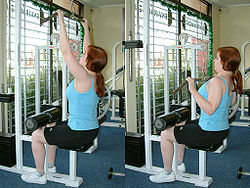
- The pulldownPulldown exerciseThe pulldown exercise or the cable lat pulldown is a strength training exercise designed to develop the latissimus dorsi muscle. It performs the functions of downward rotation and depression of the scapulae combined with adduction and extension of the shoulder joint.-Muscles:The standard pulldown...
is performed while seated by pulling a wide bar down towards the upper chest or behind the neck. This is a compound exercise that also involves the biceps, forearms, and the rear deltoids.- Equipment: cable machine or pulldown machine.
- Major variants: chin-up or pullup (using the body weight while hanging from a high bar), close grip ~ (more emphasis on the lower lats), reverse grip ~ (more emphasis on the biceps).
- The Pull-up is performed by hanging from a chin-up bar above head height with the palms facing forward (supinated) and pulling the body up so the chin reaches or passes the bar. The pull-up is a compound exercise that also involves the biceps, forearms, traps, and the rear deltoids. A chin-up (palms facing backwards) places more emphasis on the biceps and a wide grip pullup places more emphasis on the lats. As beginners of this exercise are often unable to lift their own bodyweight, a chin-up machine can be used with counterweights to assist them in the lift.
- Equipment: chin-up bar or chin-up machine.
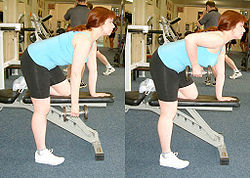
- The bent-over row is performed while leaning over, holding a weight hanging down in one hand or both hands, by pulling it up towards the abdomen. This is a compound exercise that also involves the biceps, forearms, traps, and the rear deltoids. The torso is unsupported in some variants of this exercise, in which case lifting belts are often used to help support the lower back.
- Equipment: dumbbell, barbell, Smith machine or T-bar machine.
- Major variants: cable row (using a cable machine while seated).
DeltoidsDeltoid muscleIn human anatomy, the deltoid muscle is the muscle forming the rounded contour of the shoulder. Anatomically, it appears to be made up of three distinct sets of fibers though electromyography suggests that it consists of at least seven groups that can be independently coordinated by the central...
(shoulders)
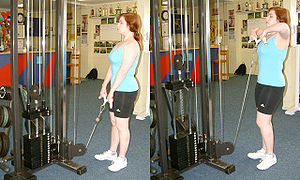
- The upright rowUpright rowThe upright row is a weight training exercise performed by holding a barbell with the overhand grip and lifting it straight up to the collarbone. This is a compound exercise that involves the trapezius, the deltoids and the biceps. The narrower the grip the more the trapezius muscles are exercised,...
is performed while standing, holding a weight hanging down in the hands, by lifting it straight up to the collarbone. This is a compound exercise that also involves the trapezius, upper back, forearms, triceps, and the biceps. The narrower the grip the more the trapezius muscles are exercised.- Equipment: dumbbells, barbell, Smith machine or cable machine.
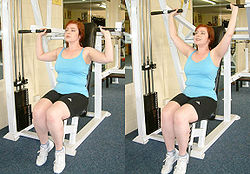
- The shoulder press is performed while seated, or standing by lowering a weight held above the head to just above the shoulders, and then raising it again. It can be performed with both arms, or one arm at a time. This is a compound exercise that also involves the trapezius and the triceps.
- The military press is similar to the shoulder press but is performed while standing with the feet together. (It is named "military" because of the similarity in appearance to the "at attention" position used in most militaries) Unlike the seated shoulder press, the military press involves the majority of the muscles of the core as stabilizers to keep the body rigid and upright, and is thus a more effective compound exercise.
- Equipment: dumbbells, kettlebells, barbell, Smith machine or shoulder press machine.
- Major variants: Arnold Press (dumbbells are raised while rotating the palms outwards).

- The lateral raise (or shoulder fly) is performed while standing or seated, with hands hanging down holding weights, by lifting them out to the sides until just below the level of the shoulders. A slight variation in the lifts can hit the deltoids even harder, while moving upwards, just turn the hands slightly downwards, keeping the last finger higher than the thumb. This is an isolation exercise for the deltoids. Also works the forearms and traps.
- Equipment: dumbbells, cable machine or lateral raise machine.
- Major variants: front raise (lift weights out to the front; emphasis is on the front deltoids), bent-over ~ (emphasis is on the rear deltoids).
TricepsTriceps brachii muscleThe triceps brachii muscle is the large muscle on the back of the upper limb of many vertebrates. It is the muscle principally responsible for extension of the elbow joint .-Terminology:...
(back of arms)
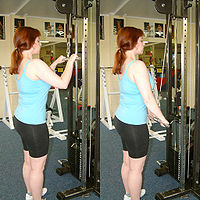
- The pushdownPushdown (exercise)A pushdown is a strength training exercise used for strengthening the triceps muscles in the back of the arm. The exercise is completed by pushing an object downward against resistance. It is a little known fact that doing the triceps pushdown also works the biceps muscle as well. This is also...
is performed while standing by pushing down on a bar held at the level of the upper chest. It is important to keep the elbows at shoulder width and in line with shoulder/legs. In other words, elbows position should not change while moving the forearm pushes down the bar. This is an isolation exercise for the triceps.
-
- Equipment: cable machine or pulldown machine.
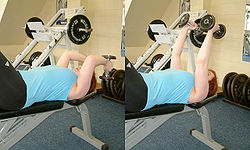
- The triceps extension is performed while standing or seated, by lowering a weight held above the head (keeping the upper arms motionless), and then raising it again. It can be performed with both arms, or one arm at a time. This is an isolation exercise for the triceps. It is also known as the french curl.
- Equipment: dumbbell(s), barbell, cable machine or triceps extension machine.
- Major variants: lying ~Lying triceps extensionsLying triceps extensions, also known as skull crushers and French extensions, are a strength exercise used in many different forms of weight lifting. Lying triceps extensions are one of the most stimulating exercises to the entire triceps muscle group in the upper arm. It works the triceps from...
(lying face up with the weights over the face), kickback (bent over with the upper arm parallel to the torso).
BicepsBiceps brachii muscleIn human anatomy, the biceps brachii, or simply biceps in common parlance, is, as the name implies, a two-headed muscle located on the upper arm. Both heads arise on the scapula and join to form a single muscle belly which is attached to the upper forearm...
(front of arms)
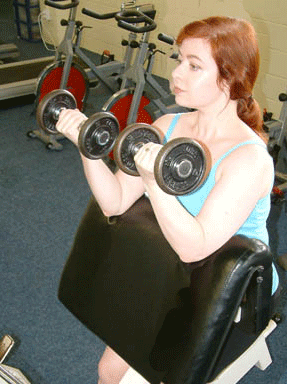
- The Preacher curl is performed while standing or seated, with hands hanging down holding weights (palms facing forwards), by curling them up to the shoulders. It can be performed with both arms, or one arm at a time.
- Standing barbell curl
- Alternating rotating dumbbell curl
- Hammer curl
- The Zottmann curl gives a stronger focus to forearm training compared to the traditional curl.
Abdominals

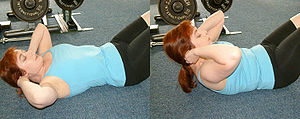
- Main article Abdominal exerciseAbdominal exerciseAbdominal exercises are those that affect the abdominal muscles .-Usage:Abdominal exercises are useful for building the abdominal muscles...
- The crunchCrunch (exercise)The crunch is one of the most common abdominal exercises. It primarily works the rectus abdominis muscle.-Form:A crunch begins with lying face up on the floor with knees bent. The movement begins by curling the shoulders towards the pelvis. The hands can be behind or beside the neck or crossed over...
is performed while lying face up on the floor with knees bent, by curling the shoulders up towards the pelvis. This is an isolation exercise for the abdominals.- Equipment: body weight, dumbbell or crunch machine.
- Major variants: reverse ~ (curling the pelvis towards the shoulders), twisting ~ or side ~ (lifting one shoulder at a time; emphasis is on the obliques), cable ~ (pulling down on a cable machine while kneeling), sit-up ~ (have chest touch your knees), vertical crunch (propping up to dangle legs and pulling knees to the chest or keeping legs straight and pulling up legs to a 90 degree position). Reverse hanging crunch (using gravity boots or slings to hang head down and pulling to a 90 or 180 degree form)
- The crunch

- The leg raiseLeg raiseLeg raise is a strength training exercise used for strengthening the abdominal muscles and hips.Leg raises without equipment are done by lying on the floor on the back. Keep the lower back in contact with the floor and place hands to sides or under lower back for support. Lift legs upward as far as...
is performed while sitting on a bench or flat on the floor by raising the knees towards the shoulders, or legs to a vertical upright position. This is a compound exercise that also involves the hip flexorsHip flexorsIn human anatomy, the hip flexors are a group of skeletal muscles that act to flex the femur onto the lumbo-pelvic complex, i.e., pull the knee upward....
.- Equipment: body weight or dumbbell.
- Major variants: hanging ~ (hanging from a high bar), side ~ (lying on side), knee raise (lying on back, drawing knees to chest).
Back extension
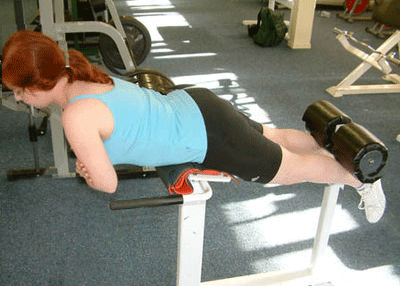
Back extension
Back extension is a strength training exercise. It is done for strengthening lower back muscles.Using equipment, it can be done by lowering the body from a stand and raising back using the roman chair, or using a back extension machine where body pushes a weight backwards.Without using equipment,...
is performed while lying face down partway along a flat or angled bench, so that the hips are supported and the heels secured, by bending down at the waist and then straightening up again. This is a compound exercise that also involves the glutes.
Equipment: Body weight, dumbbell or back extension machine.
Major variants: Without bench (lying face down on the floor).
Deadlift
The deadliftDeadlift
The deadlift is a weight training exercise where a loaded barbell is lifted off the ground from a stabilized, bent over position. It is one of the three canonical powerlifting exercises, along with the squat and bench press.-Overview:...
is a very effective compound exercise for strengthening the lower back, but also exercises many other major muscle groups, including quads, hamstrings and abdominals. It is a challenging exercise, as poor form or execution can cause serious injury.
A deadlift is performed by grasping a dead weight on the floor and, while keeping the back very straight, standing up by contracting the erector spinae (primary lower back muscle). When performed correctly the role of the arms in the deadlift is only that of cables attaching the weight to the body; the musculature of the arms should not be used to lift the weight. There is no movement more basic to everyday life than picking a dead weight up off of the floor, and for this reason focusing on improving one's deadlift will help prevent back injuries.
Good-morning
The Good-morningGood-morning
The good-morning is a weight-lifting exercise. The movement resembles bowing to greet someone "good morning". The erector spinae muscles of the lower back work isometrically to keep the spine in an extended position while the hamstrings and gluteus maximus work isotonically to perform hip extension...
is a weight training exercise in which a barbell, two dumbbells, or no weight at all is held on the shoulders, behind the head. The person bends forward and bows at the hips and recovers to upright. The good-morning is so called because the movement resembles bowing to greet someone. It involves the hamstrings but is primarily used to strengthen the lower back; the degree of knee bend used will change the focus – nearly straight-legged involving the hamstrings most.

